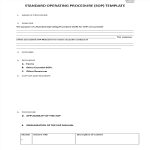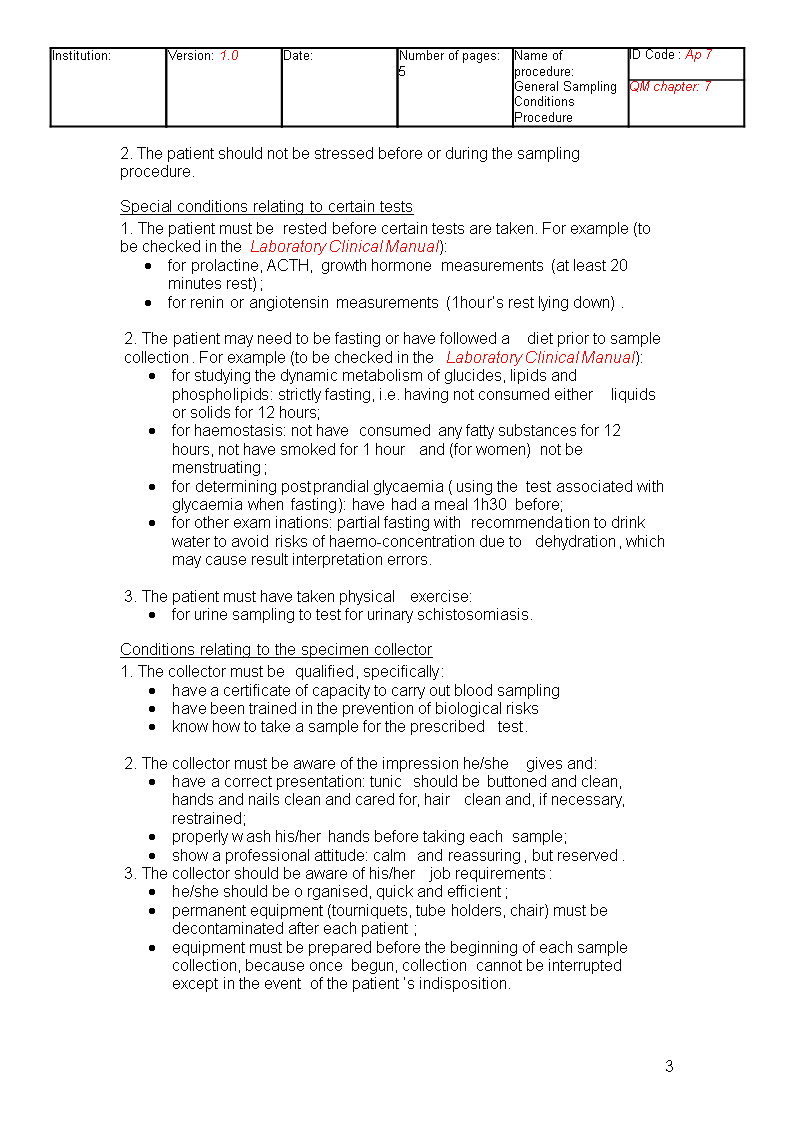Sampling Conditions SOP
Save, fill-In The Blanks, Print, Done!

Download Sampling Conditions SOP
Microsoft Word (.doc)Or select the format you want and we convert it for you for free:
- This Document Has Been Certified by a Professional
- 100% customizable
- This is a digital download (68 kB)
- Language: English
- We recommend downloading this file onto your computer.
How to create a Sampling Conditions SOP to ensure optimal conditions in a laboratory for specimen collection? Have a look at this Quality Management SOP template and customize it according to your needs.
This SOP explains optimal conditions for sampling and ensures optimal conditions for specimen collection in a laboratory. The objective of this SOP is that this operating mode explains the conditions that the patient and the specimen collector must fulfill to ensure smooth operation and good quality sample and it contains the following contents:
This SOP explains optimal conditions for sampling and ensures optimal conditions for specimen collection in a laboratory. The objective of this SOP is that this operating mode explains the conditions that the patient and the specimen collector must fulfill to ensure smooth operation and good quality sample and it contains the following contents:
- Definitions
- Application,
- Objective,
- Definitions,
- References,
- Responsibilities,
- Operating mode,
- Related documents,
- Methodology
- Conditions relating to the patient
- Special conditions relating to certain tests
- Conditions relating to the specimen collector
- Potential adverse outcomes relating to the patient’s condition
- Potential adverse outcomes relating to the specimen collector
- Annex.
This quality template is based on international standards and provides an example that shows how to write policies and procedures that together will form your Quality Management System (QMS). The size and complexity of your organization and its individual processes will determine if this Sampling Conditions SOP is useful for your organization. It will support and improve the existing Quality Management System works and controls that are already in place to manage each process. It demonstrates the commitment to meeting your customer expectations’ by delivering quality products and/or services.
By implementing this Sampling Conditions SOP in your organization, you will improve your Quality Management System or compliance with QMS systems such as ISO 9001. A QMS in its basic concept is not too complicated. Many organizations are struggling with the idea they are required to implement a lot of bureaucratic documents and protocols and ask themselves, whether or not it’s worth trying to develop such a seemingly complicated system. It is not necessarily a complicated system that is needed. Guidance on having clear and concise communication throughout the organization’s documents and between departments does also not have to be elaborated.
It’s important that you can set expectations from both management and employees and you follow a framework, such as ISO 9001, in order to prevent making it too complicated and ensuring you have an integrated solution for the whole company. When you follow this approach, and you determine processes and their interactions, inputs, and outputs in your organization.
Download this Sampling Conditions Laboratory Procedure now and you will find out it’s very helpful for your company to improve the quality level by measuring, monitoring, and reporting about the performance of the business processes and gradually improve the company output. Other primary quality control tools, such as checklists, fishbone diagrams, control charts, manuals, charts, reports, can be found here: Quality Management Templates.
DISCLAIMER
Nothing on this site shall be considered legal advice and no attorney-client relationship is established.
Leave a Reply. If you have any questions or remarks, feel free to post them below.
Quality Management Templates
These quality templates are based on international standards and provides and help to write quality policies and procedures
Read moreRelated templates
Latest templates
Latest topics
- Excel Templates
Where do I find templates for Excel? How do I create a template in Excel? Check these editable and printable Excel Templates and download them directly! - GDPR Compliance Templates
What do you need to become GDPR compliant? Are you looking for useful GDPR document templates to make you compliant? All these compliance documents will be available to download instantly... - Google Docs Templates
How to create documents in Google Docs? We provide Google Docs compatible template and these are the reasons why it's useful to work with Google Docs... - IT Security Standards Kit
What are IT Security Standards? Check out our collection of this newly updated IT Security Kit Standard templates, including policies, controls, processes, checklists, procedures and other documents. - Letter Format
How to format a letter? Here is a brief overview of common letter formats and templates in USA and UK and get inspirited immediately!
cheese


